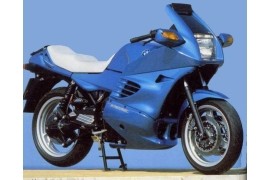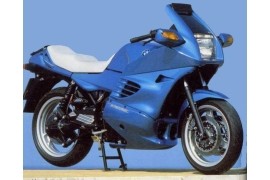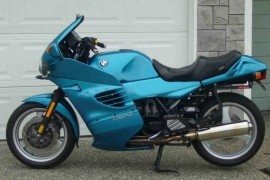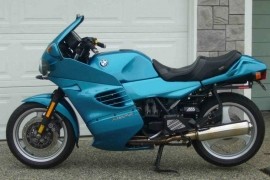BMW K 1100 Models/Series Timeline, Specifications & Photos
First production year: 1992
In 1995, the German motorcycle maker released the BMW K1100 RS, a half-faired motorcycle that handled both urban jungle and longer hauls. The bike came as the successor of the K100 RS and was replaced by the slightly larger-displacement K1200 RS.
The 1995 machine was similar to the previous one, featuring the same package as the previous one delivering the same technical, visual, and performance specifications without any modifications whatsoever.
The aesthetic department was characterized by standard fittings, like a half fairing with a square headlight and a windscreen, a one-piece dual seat with passenger grab handles, a four-into-one exhaust system with a silencer mounted on the left-hand side, a center stand, and three-spoke aluminum alloy wheels.
Suspension-wise, the motorcycle's ride was softened by a 43 mm telescopic fork on the front and a monolever swingarm coupled to a right-hand side-mounted shock absorber on the rear, all mounted on a tubular steel space frame.
As for the braking power, the bike's wheels were equipped with two 305 mm brake discs on the front and a single 285 mm brake disc on the rear. The front discs were assisted by four-piston calipers, while the rear one was handled by a single-piston caliper.
As for power, the 1995 BMW K1100 RS had installed a 1,092cc four-stroke liquid-cooled four-cylinder engine mounted underneath the fuel tank, boasting 100 hp at 7,500 rpm and 107 Nm (79 lb-ft) torque at 5,500 rpm.
The BMW K1100 RS was a half-faired motorcycle that came into the motorcycling world as the successor of the BMW K100 RS and continued production until it was replaced by the K1200 RS.
In 1994, the German motorcycle manufacturer launched the BMW K1100 RS, a half-faired performance-oriented machine that could also tackle longer hauls. For an aggressive appearance, the model had grills embedded on each side of the fairing, which was considered a bold touch by the standards at the time.
The 1994 model came in the same shape and form as the previous one, providing the same technical, visual, and performance specifications without any significant modifications.
The bike's aesthetic department was characterized by standard fittings, such as a half fairing with a square headlight and a windscreen, a one-piece dual seat with passenger grab handles, a four-into-one exhaust system with a silencer mounted on the left-hand side, a center stand, and three-spoke aluminum alloy wheels.
As for the power figures, the 1994 BMW K1100 RS had its soul brought to life by a 1,092cc four-stroke liquid-cooled four-cylinder engine fed by a fuel injection system. It boasted 100 hp with a peak force at 7,500 rpm and 107 Nm (79 lb-ft) torque at 5,500 rpm.
Set in motion by a five-speed gearbox that delivered the engine's power to the rear wheel via a final shaft drive, the K1100 RS reached a top speed of 225 kph (140 mph).
In 1993, the German motorcycle maker released the BMW K1100 RS, a half-faired successor of the K100 RS. The bike was replaced by the BMW K1200 RS, which, as its name says, had a slightly larger displacement.
In the aesthetic department, the bike packed standard features, such as half fairing, an upper cowl similar to its predecessor's with a large square headlight and a small windscreen, a one-piece dual seat with pillion grab rails, a center stand, a four-into-one exhaust system with a muffler mounted on the left-hand side, and three-spoke aluminum wheels.
The bike was built around a tubular steel space frame, fitted with a 43 mm telescopic fork on the front and a monolever swingarm with a right-hand side-mounted shock absorber on the rear, offering optimum suspension performance and handling.
The bike's braking power was handled by two 305 mm brake discs assisted by four-piston calipers on the front wheel and a 285 mm brake disc with a single-piston caliper mounted on the rear wheel.
As for the power figures, the BMW K1100 RS had installed a 1,092cc four-stroke four-cylinder liquid-cooled engine underneath its fuel tank. The engine was fed by a fuel injection system and delivered an output power of 100 hp at 7,500 rpm and 107 Nm (79 lb-ft) torque at 5,500 rpm.
Since the release of the BMW K 1100 LT, fans waited for the bored-out 1100cc engine to be adopted in the RS chassis, which BMW realized in 1992 with the launch of the K 1100 RS model.
The engine transplantation was not the only change made to the bike but also received a facelift with the upper part of the fairing borrowed from the K 100 RS and a completely redesigned lower part that covered the engine with a directly attached spoiler like on the K1 model.
For an aggressive appearance, the model had grills embedded on each side of the fairing, which by the standards at the time were considered an aggressive touch.
Another great touch was the updated 1092cc in-line four-cylinder engine that helped the bike to achieve impressive driving performance. With a power output of 100 hp at 7,500 rpm and 107 Nm (79 lb-ft) of incomparable pulling torque available at 5,500 rpm, the bike reached a top speed of 220 kph (138 mph).
The 1992 BMW K 1100 RS came with standard features such as an analog instrument cluster, cast-aluminum wheels, a dual seat, passenger grab handles, and a center stand.
As a side note, in 1995, BMW launched a special model in bright Red with a Black application finish, and in 1996, a second version of the special model was released in an elegant Black/Silver with telescopic sliders polished to a high gloss, that finally marked the end of the K 1100 series.



